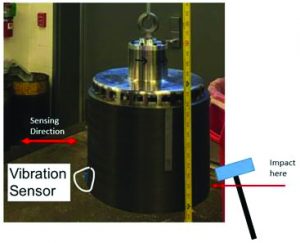Trunnion Effect on a PMSM with External Rotor Designs
MS student Yangxue (Sherry) Yu with advisor K. Haran
It is important to understand rotor dynamics and correctly capture the rotor’s critical frequencies to predict and improve a motor’s performance. For an external rotor design, the presence of the trunnion effect, modeled as a rotational stiffness at the hub of the trunnion plate, may shift the first critical speed of the rotor downward. When this speed falls within operational range, the system will experience vibration and may sustain severe damage if the system is not well balanced. Therefore, it is crucial to identify the critical speed due to the trunnion effect before testing. In this study, rotational stiffness is calculated from a base model and XLrotor is used to simulate the rotor free-free mode. A ping test is performed on the rotor to determine the trunnion-effect frequency. Figure 4 shows the test setup. By comparing the simulation and ping-test result, the base model is calibrated and applied to the rotor-dynamics simulation of the entire drive train. This research is supported by Zhejiang University.
